JavaScript Closures Example
Greetings readers, in this tutorial, we will understand Closures in the JavaScript language.
1. Introduction
JavaScript is an object-oriented programming language that allows the client-side scripting to interact with a user and deliver the dynamic pages. Most web browsers including Google Chrome, Mozilla Firefox, Safari, Internet Explorer, Microsoft Edge, Opera, etc. support it. The JavaScript scripting language includes:
- Declaring variables
- Maintaining the retrieving values
- Defining and invoking functions
- Defining classes
- Load and use external modules
- Define event handlers
- And much more ….
1.1 Advantages of JavaScript Language
The pros of using the JavaScript scripting language are:
- JavaScript is easy to learn
- It executes on client’s browser, so eliminates the server-side processing and be executed on any OS
- JavaScript can be used with any type of web page e.g. PHP, ASP.NET, Perl etc
- Web-page performance increases due to client-side execution
- JavaScript code can be minified to decrease the loading time from the server
- Many JavaScript-based application frameworks are available in the market to create Single page web applications e.g. AngularJS, ReactJS etc.
1.2 Disadvantages of JavaScript Language
The cons of using the JavaScript scripting language are:
- No support for networking applications
- Does not have any multi-threading or multi-processing capabilities
- Does not allow the file reading and writing capabilities
1.3 Closures in JavaScript Language
- It is an inner function that has access to outer function’s variables and parameters in addition to its own and global variables
- Users can create a closure by defining a function inside another function
- The scope of the closure is defined statically by its location within the source code
- Usage:
- Maintain a private reference to a variable in the outer scope
2. JavaScript Closures Example
Here is a systematic guide for implementing this tutorial using the JavaScript language.
2.1 Tools Used
We are using Eclipse Kepler SR2, JDK 8 and Maven. Having said that, we have tested the code against JDK 1.7 and it works well.
2.2 Project Structure
Firstly, let us review the final project structure if you are confused about where you should create the corresponding files or folder later!
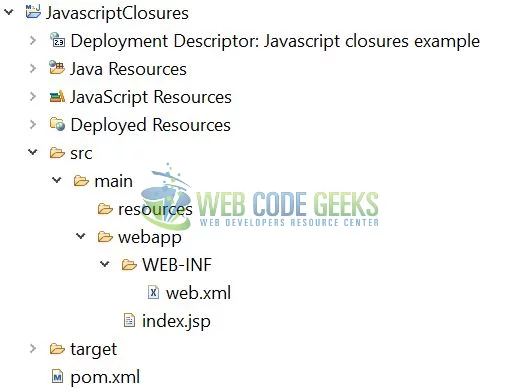
2.3 Project Creation
This section will show on how to create a Java-based Maven project with Eclipse. In Eclipse Ide, go to File -> New -> Maven Project.
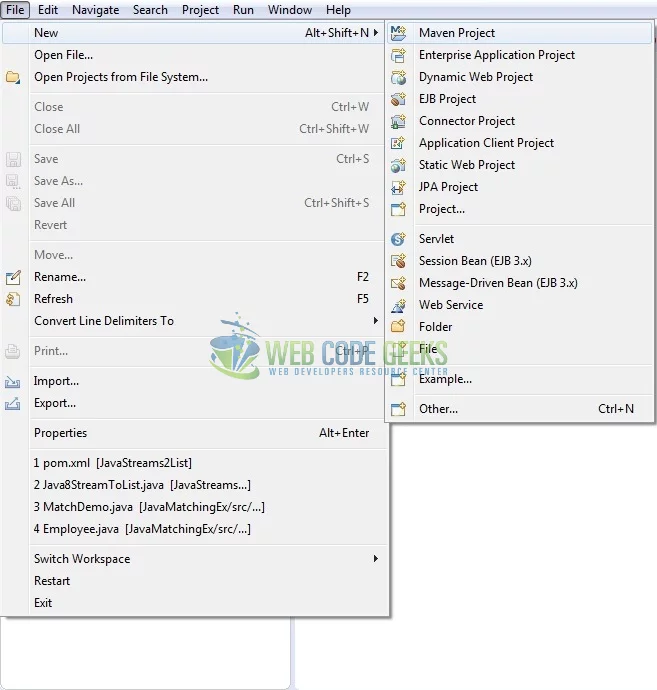
In the New Maven Project window, it will ask you to select the project location. By default, ‘Use default workspace location’ will be selected. Just click on the next button to proceed.
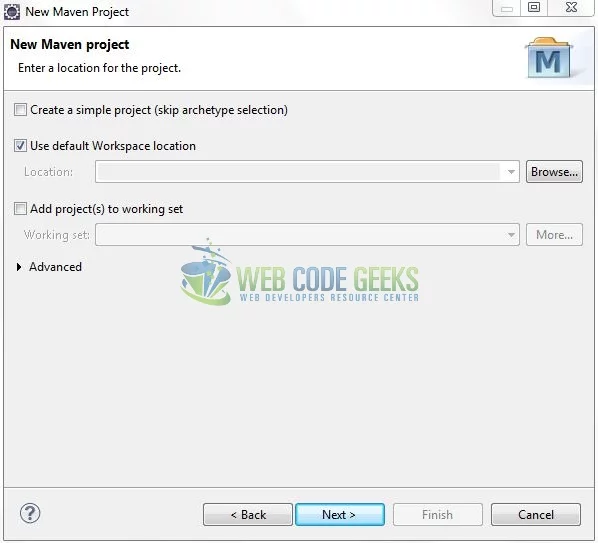
Select the ‘Maven Web App’ Archetype from the list of options and click next.
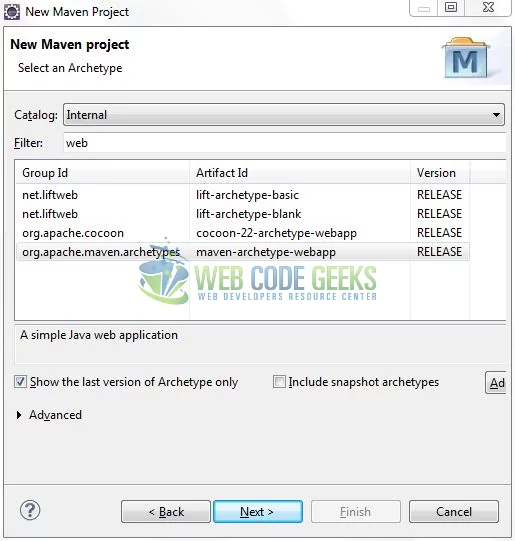
It will ask you to ‘Enter the group and the artifact id for the project’. We will input the details as shown in the below image. The version number will be by default: 0.0.1-SNAPSHOT.
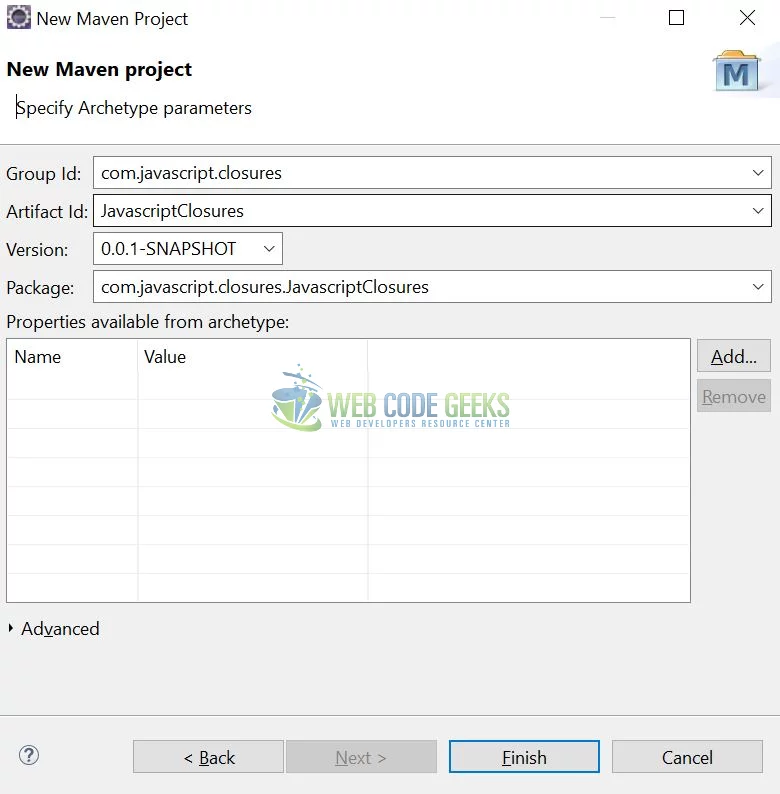
Click on Finish and the creation of a maven project is completed. If you see, it has downloaded the maven dependencies and a pom.xml file will be created. It will have the following code:
pom.xml
<project xmlns="http://maven.apache.org/POM/4.0.0" xmlns:xsi="http://www.w3.org/2001/XMLSchema-instance" xsi:schemaLocation="http://maven.apache.org/POM/4.0.0 http://maven.apache.org/xsd/maven-4.0.0.xsd"> <modelVersion>4.0.0</modelVersion> <groupId>com.javascript</groupId> <artifactId>JavascriptClosures</artifactId> <version>0.0.1-SNAPSHOT</version> <packaging>war</packaging> </project>
3. Application Building
Let us create an application to understand the basic building blocks of this tutorial.
3.1 Define the HTML
Let us write a simple index page in the JavascriptClosures/src/main/webapp/ folder. Add the following code to it:
index.jsp
<!-- Javascript closures tutorial --> <div id="title"> <h4 class="text-info">What is a Closure?</h4> <ul> <li>It is an inner function that has access to outer function's variables and parameters in addition to it's own and global variables.</li> <li>Users can create a closure by defining a function inside another function.</li> <li>The scope of the closure is defined statically by its location within the source code.</li> <li>Usage: <ul> <li>Maintain a private reference to a variable in the outer scope.</li> </ul> </li> </ul> </div> <div> </div> <button id="btn_submit" type="button" class="btn btn-success" onclick="clicks();">Click me</button> <div> </div> <div id="result"></div>
3.2 Define the JavaScript function
Let us write a simple javascript function that will help developers understand the closures in the javascript language. Add the following code to it:
JavaScript function
var clicks = (function ()
{
var count = 0;
return function() {
document.getElementById("result").innerHTML = ++count;
}
})();
3.3 First application
Complete the above steps and save the file. Let us see the sample code snippet.
index.jsp
<!DOCTYPE html>
<html lang="en">
<head>
<title>Index page</title>
<meta http-equiv="Content-Type" content="text/html; charset=ISO-8859-1">
<link rel="stylesheet" href="https://www.webcodegeeks.com/wp-content/litespeed/localres/aHR0cHM6Ly9zdGFja3BhdGguYm9vdHN0cmFwY2RuLmNvbS8=bootstrap/4.1.3/css/bootstrap.min.css">
</head>
<body>
<div class="container">
<h2 align="center" class="text-danger">Closures in JavaScript</h2>
<hr />
<!-- Javascript closures tutorial -->
<div id="title">
<h4 class="text-info">What is a Closure?</h4>
<ul>
<li>It is an inner function that has access to outer function's variables and parameters in addition to it's own and global variables.</li>
<li>Users can create a closure by defining a function inside another function.</li>
<li>The scope of the closure is defined statically by its location within the source code.</li>
<li>Usage:
<ul>
<li>Maintain a private reference to a variable in the outer scope.</li>
</ul>
</li>
</ul>
</div>
<div> </div>
<button id="btn_submit" type="button" class="btn btn-success" onclick="clicks();">Click me</button>
<div> </div>
<div id="result"></div>
</div>
<script>
var clicks = (function ()
{
var count = 0;
return function() {
document.getElementById("result").innerHTML = ++count;
}
})();
</script>
</body>
</html>
4. Run the Application
As we are ready for all the changes, let us compile the project and deploy the application on the Tomcat7 server. To deploy the application on Tomat7, right-click on the project and navigate to Run as -> Run on Server.
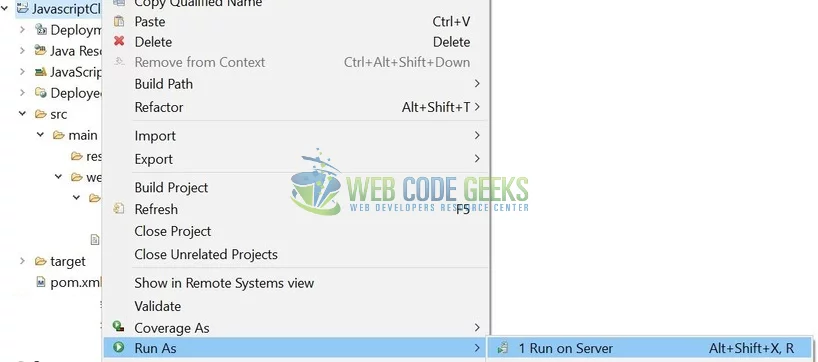
Tomcat will deploy the application in its web-apps folder and shall start its execution to deploy the project so that we can go ahead and test it in the browser.
5. Project Demo
Open your favorite browser and hit the following URL to display the application’s index page as shown in Fig. 7.
http://localhost:8082/JavascriptClosures/
Server name (localhost) and port (8082) may vary as per your Tomcat configuration.

Users can click the button to display and increment the click counter. That is all for this tutorial and I hope the article served you whatever you were looking for. Happy Learning and do not forget to share!
6. Conclusion
In this section, developers learned how to create a simple application with the JavaScript language. Developers can download the sample application as an Eclipse project in the Downloads section.
7. Download the Eclipse Project
This was a beginners tutorial to understand the closures in the javascript language.
You can download the full source code of this example here: JavascriptClosures


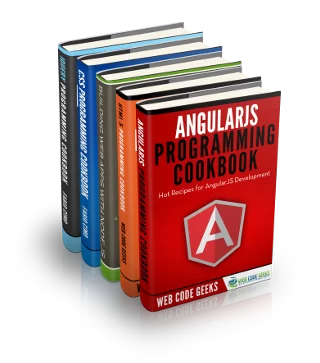

This is a good article… but… You have to know none of the things you mention in Javascript cons are actually true anymore..
A type of multithreading can be achieved with webworkers (https://www.w3schools.com/hTml/html5_webworkers.asp),
File/File System access can be granted using html 5 File API (https://www.html5rocks.com/en/tutorials/file/dndfiles/)
Im not really sure what you mean by “No support for networking applications” so maybe that one is right?
Yatin, does a good job explaining what JavaScript closure are but his approach to presenting the subject matter is rather dated and and shows his knowledge is heavily reliant of his experience as a Java developer. First, JavaScript is no longer just a client-side language. Frameworks such as Node JS and Express JS make server-side JavaScript application development one of the biggest trends in web application development in recent years. His criticisms of JavaScript not supporting network programming or concurrency are simply no longer true. Second I found it somewhat puzzling that subject would be presented using JSP pages and… Read more »